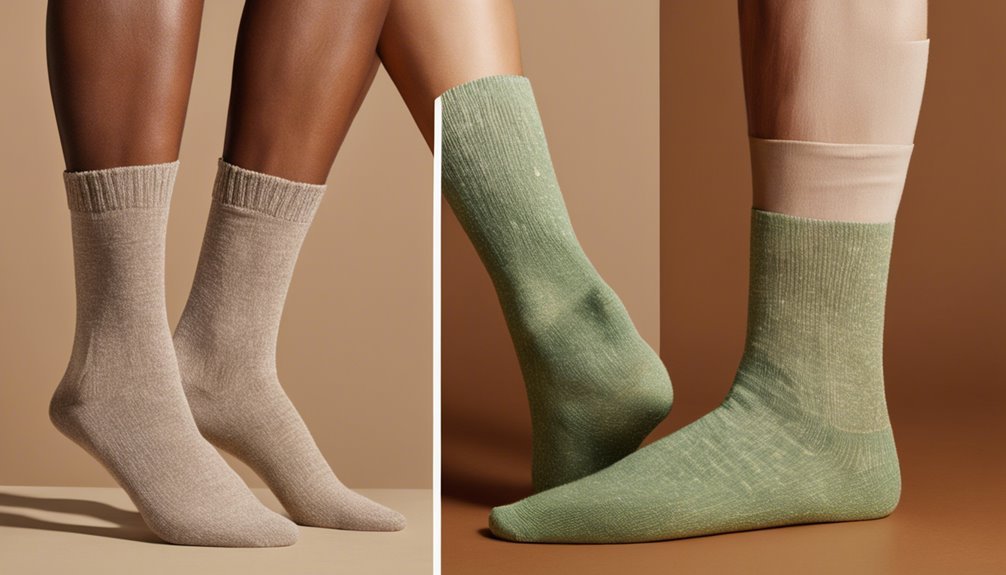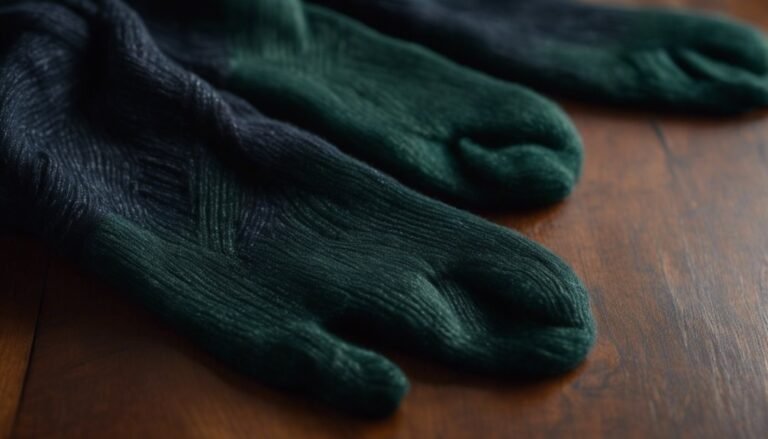Synthetic Socks vs. Biodegradable Socks: What’s the Future?
When considering synthetic socks versus biodegradable socks, it's clear you face an essential choice. Synthetic socks offer exceptional durability and moisture management, ideal for active lifestyles. However, biodegradable socks support eco-friendly practices, breaking down naturally and reducing your carbon footprint. As consumer preferences shift towards sustainability, the future leans toward innovative, sustainable options that don't compromise performance. Exploring these trends will help you make informed decisions about your footwear choices and their impact on the environment.
Understanding Synthetic Socks: Materials and Benefits

When it comes to choosing the right socks, understanding synthetic materials can greatly impact your decision. Synthetic fibers, like polyester and nylon, are engineered for performance. They excel in moisture management, wicking sweat away from your skin and keeping your feet dry and comfortable. This is especially important if you value freedom in your activities, whether you're hiking, running, or just enjoying a day out. Unlike cotton, which can retain moisture, synthetic socks dry quickly, reducing the risk of blisters and discomfort. Plus, they offer durability, ensuring your socks withstand the rigors of your adventurous lifestyle. Embracing synthetic socks means embracing reliable performance, helping you stay focused on enjoying life without limitations.
The Environmental Impact of Synthetic Materials
When considering synthetic socks, it's essential to recognize their environmental footprint. The resource consumption involved in producing synthetic materials often leads to significant pollution and waste, impacting ecosystems. As you weigh your options, think about how these factors align with your values regarding sustainability and environmental responsibility.
Resource Consumption Concerns
Although synthetic materials have revolutionized the textile industry with their durability and cost-effectiveness, their environmental impact raises significant resource consumption concerns. The production of synthetic socks often leads to resource depletion, as fossil fuels are extracted for manufacturing processes. This unsustainable practice not only threatens our planet but also compels you to contemplate the ethical sourcing of materials. As you grapple with choices, remember that opting for biodegradable socks supports a shift towards sustainable practices that prioritize the planet's health. By choosing wisely, you can help reduce the strain on natural resources and promote a market that values eco-friendly options. Embrace your freedom to make informed decisions that align with your values and contribute to a more sustainable future.
Pollution and Waste Issues
The environmental ramifications of synthetic materials extend beyond resource consumption to significant pollution and waste issues. When you consider how synthetic socks contribute to pollution sources, it's alarming. These products often end up in landfills, releasing harmful chemicals as they break down. In contrast, biodegradable options offer a more sustainable alternative, minimizing long-term environmental impact. Effective waste management is essential, but with synthetic materials dominating the market, many waste systems struggle to cope. You have the power to make choices that reflect your values. Opting for biodegradable socks not only reduces the pollution footprint but also supports a movement towards eco-friendly practices. Your choices matter, and embracing sustainability can lead to a cleaner, healthier planet for all.
Exploring Biodegradable Socks: Composition and Features
When you consider biodegradable socks, it's essential to understand the eco-friendly materials that make them stand out. These socks often incorporate organic fibers like bamboo and organic cotton, providing not just a sustainable choice but also enhanced comfort and performance. By choosing biodegradable options, you're not only benefiting your feet but also contributing to a healthier planet.
Eco-Friendly Materials Used
As you consider your sock choices, it's important to recognize the significance of eco-friendly materials in biodegradable socks. These socks often utilize eco-friendly fibers like organic cotton, bamboo, and Tencel, which not only reduce your carbon footprint but also provide a more sustainable alternative to traditional materials. By choosing socks made from these fibers, you're supporting sustainable sourcing practices that prioritize the health of our planet. Each step you take in selecting biodegradable options contributes to a larger movement towards reducing waste and promoting environmental responsibility. In a world where consumer choices matter, opting for biodegradable socks means you're not just investing in your comfort, but also embracing a lifestyle that champions freedom through sustainable living.
Comfort and Performance Features
While many may assume that eco-friendly materials sacrifice comfort for sustainability, biodegradable socks prove that you don't have to compromise on performance. These innovative socks often utilize natural fibers like organic cotton or bamboo, which enhance breathability factors, allowing your feet to stay cool and dry. You'll appreciate their excellent moisture management, drawing sweat away from your skin and reducing the risk of blisters. Additionally, the softness of these materials guarantees a cozy fit, making them perfect for all-day wear. With biodegradable socks, you're not just making an eco-conscious choice; you're also investing in comfort and functionality. So, if you value freedom in your active lifestyle, these socks might just be the ideal blend of sustainability and performance you've been seeking.
Advantages of Choosing Biodegradable Socks
Choosing biodegradable socks not only benefits the environment but also aligns with a growing commitment to sustainability. By opting for socks made from natural materials, you're supporting sustainable fashion that minimizes waste and pollution. Unlike synthetic alternatives, biodegradable socks break down naturally, reducing landfill contributions and environmental impact. You'll feel good knowing your choices reflect a conscious lifestyle, promoting eco-friendliness while still enjoying comfort. Additionally, these socks often maintain breathability and softness, enhancing your overall wearing experience. Embracing biodegradable options empowers you to contribute to a cleaner planet and encourages manufacturers to innovate in sustainable practices. So, why not make the switch? Your feet—and the Earth—will thank you for it.
Performance Comparison: Synthetic vs. Biodegradable
The eco-friendly benefits of biodegradable socks are compelling, but performance is another vital aspect to contemplate. When it comes to moisture management, synthetic socks often outperform their biodegradable counterparts, wicking sweat away from your feet and keeping them dry during intense activities. This can be essential for athletes or anyone on the go. Additionally, synthetic materials excel in temperature regulation, adapting to varying conditions and ensuring comfort throughout the day. While biodegradable options may offer some breathability, they typically can't match the performance of synthetics in these areas. If you value freedom in your active lifestyle, consider how these factors impact your experience. Ultimately, balancing eco-conscious choices with performance is key to finding the right sock for your needs.
Longevity and Durability: Which Lasts Longer?

Longevity and durability are essential factors when evaluating socks, especially for those who value both performance and sustainability. In longevity testing, synthetic socks often outlast their biodegradable counterparts due to their resistance to wear and tear. However, durability comparisons reveal that biodegradable options can still offer impressive lifespan when crafted with high-quality materials.
- Synthetic socks generally withstand more rigorous use.
- Biodegradable socks tend to degrade faster under harsh conditions.
- The environmental impact of each option may influence your choice.
Ultimately, if you prioritize long-lasting wear, synthetic socks might be your best bet. But if sustainability drives you, consider the balance between performance and eco-friendliness that biodegradable socks can provide. Your choice shapes the future of sock innovation.
Cost Analysis: Price Differences Between Options
While comparing synthetic and biodegradable socks, it's important to take into account the cost implications of each option. A detailed cost breakdown reveals that synthetic socks often have a lower upfront price, typically ranging from $5 to $15 per pair. In contrast, biodegradable socks can cost between $10 to $25 due to eco-friendly materials. However, considering price trends, synthetic options might require more frequent replacements, potentially raising long-term costs. Biodegradable socks, while pricier initially, may offer greater value as they often last longer and align with sustainable practices. Ultimately, your choice might depend on how you weigh immediate savings against the commitment to a greener future, allowing you the freedom to make an informed decision that reflects your values.
Consumer Preferences: Trends in Sock Choices
As consumers weigh the cost differences between synthetic and biodegradable socks, their choices reveal shifting preferences towards sustainability and ethical manufacturing. You're likely noticing a trend where fashion trends align with eco-conscious consumer behavior. More people are seeking products that reflect their values, pushing brands to prioritize environmentally friendly practices.
Consider these factors influencing your sock choices:
- Increased awareness of environmental issues
- Desire for ethically produced materials
- Preference for comfort and durability
This shift not only shapes your purchasing habits but also encourages manufacturers to innovate. By choosing biodegradable options, you're part of a growing movement that values freedom through sustainable choices, allowing you to wear your values proudly on your feet.
Innovations in Sustainable Sock Technology

With the rise of eco-conscious consumerism, innovations in sustainable sock technology are transforming how you think about your footwear. Brands are now leveraging sustainable innovations to create socks that not only deliver on comfort and style but also respect the planet. You'll find options made from eco-friendly materials like organic cotton, bamboo, and recycled fibers, which greatly reduce environmental impact. These socks often feature advanced moisture-wicking properties and durability, proving that sustainability doesn't compromise performance. As you explore these choices, consider how these innovations align with your values and lifestyle. Embracing sustainable options allows you to enjoy freedom in your fashion choices while contributing to a healthier planet. It's a win-win for you and the environment.
Making an Informed Decision for Sustainable Footwear
When choosing between synthetic and biodegradable socks, you need to evaluate their environmental impact alongside performance and durability. Synthetic materials often provide enhanced longevity, but they can contribute to pollution, while biodegradable options are more eco-friendly yet may wear out faster. Weighing these factors will help you make a smarter, more sustainable footwear choice.
Environmental Impact Comparison
Although synthetic socks may boast durability and moisture-wicking properties, their environmental impact raises significant concerns. As a conscious consumer, you should consider the broader implications of your choices. Biodegradable socks, made from natural fibers, offer a sustainable alternative that aligns with eco-friendly practices.
Consider these factors:
- Plastic Pollution: Synthetic socks contribute to microplastics in oceans.
- Resource Usage: Manufacturing synthetic materials often consumes non-renewable resources.
- Decomposition: Biodegradable options break down naturally, reducing landfill waste.
Performance and Durability Factors
While you might be drawn to synthetic socks for their impressive performance metrics, it is crucial to weigh these benefits against the long-term implications for both your comfort and the environment. Synthetic options excel in breathability factors and moisture management, keeping your feet dry and cool during intense activities. However, biodegradable socks offer a different kind of performance, prioritizing sustainability without sacrificing comfort.
| Feature | Synthetic Socks | Biodegradable Socks |
|---|---|---|
| Breathability Factors | High | Moderate |
| Moisture Management | Excellent | Good |
| Durability | Very High | Moderate |
| Environmental Impact | Low | High |
| Comfort | High | High |
Consider these factors carefully; your choice can influence both your performance and the planet's future.
Frequently Asked Questions
Are Synthetic Socks Recyclable After Their Life Cycle Ends?
Synthetic socks aren't typically recyclable due to their material composition. The recycling process for synthetic fabrics is complex, often leading to landfill disposal instead. Consider alternatives that prioritize sustainability for a more eco-friendly choice.
Do Biodegradable Socks Decompose in Landfills or Require Special Conditions?
Did you know that only 9% of plastic gets recycled? Biodegradable materials can decompose in landfills, but they often need specific conditions, like moisture and heat, for effective landfill decomposition. So, it's complicated.
How Do Synthetic Socks Affect Foot Health Compared to Biodegradable Options?
When considering foot health, synthetic socks often excel in moisture management, reducing foot odor. However, biodegradable options can be healthier for your skin, promoting breathability and comfort. Ultimately, it's about finding what works best for you.
Can Biodegradable Socks Perform Well in Extreme Weather Conditions?
When considering biodegradable socks, performance testing reveals they can adapt to extreme weather conditions. Their natural materials often enhance breathability and moisture-wicking, providing comfort and support, allowing you to embrace outdoor adventures without compromise.
What Brands Are Leading in Sustainable Sock Innovations Today?
You'll find sustainable brands like Allbirds and Bombas leading the charge with innovative materials. These companies prioritize eco-friendly practices, crafting socks that not only perform well but also contribute positively to the environment, aligning with your values.







